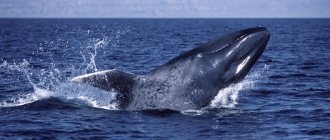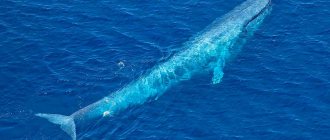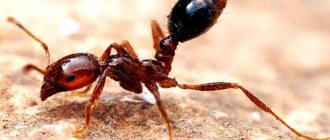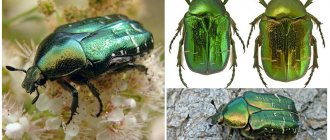The seas and oceans are home to many creatures that are similar in physique to fish, but at the same time breathe air, give birth to live young and feed them with milk. An example of this is the blue whale.
The blue whale is the greatest traveler among marine mammals. They go to sea only occasionally. Their home is the world's oceans. At the moment, there are 11,000 of these huge animals left in the world's oceans and therefore hunting for this whale is now prohibited.
Appearance
The average body length is from 22 to 27 meters, and females are larger than males; weight can reach 190 tons. The blue whale got its name from the bluish tint on its back, and these whales are nicknamed minke whales. He received this nickname because of the many parallel stripes and folds on his belly. Like all baleen whales (filter feeders), the blue whale has no teeth. Instead, he has hundreds of special fringed plates (whalebone) used for straining food. In addition, he has the largest tongue in the world, the size of a car. The whale's tail is horizontal and can lie on the surface of the water. While swimming, whales make vertical movements with them up and down. Whales lack external hearing organs traditional for animals - ears. They hear through the lower jaw, from which sound travels to the middle ear, and then to the inner ear.
The tail of a blue whale can be compared to a human fingerprint: grooves, cuts, scars and patches of brown algae create unique imprints. If necessary, a whale can not sleep for three months, and if the animal does fall asleep, it is only at a shallow depth, almost at the very surface. Due to the high content of the fat layer, the weight of the whale slightly exceeds the specific gravity of water, so a sleeping whale sinks down very slowly and can drown.
The nature of the whale's life
These whales live solitary lives, roaming the ocean between subtropical waters and near the poles. Populations from the Northern and Southern Hemispheres never meet. In cold water, whales maintain a body temperature close to that of a human, thanks to a thick layer of fat (about 50 cm) under the skin, which protects the internal organs from hypothermia. Also known by the scientific name: Balaenoptera musculus, the blue whale usually lives alone or in pairs, but small groups of up to fifty individuals have occasionally been reported. Blue whales prefer cold and temperate waters. Whales enter waters from Greenland to Spitsbergen and Novaya Zemlya, and into the Chukchi Sea. These whales are not found in the Beaufort, Laptev, East Siberian and Kara seas, since in warm climates parasites stick to their skin, causing the body to become covered with ulcers. If an animal the size of an adult whale lived on land, it would require the thickest bones imaginable to support its enormous weight. In the sea, the body is supported by water, and therefore the absence of massive bones does not matter.
The blue whale has a streamlined body, a flattened head, and a usually smooth body - only sometimes fish called suckers stick to its sides. The blue whale is a surprisingly good swimmer, capable of developing fantastic speeds, despite its enormous size. If disturbed, it can even swim at the city speed limit of a car.
Population today
Today, blue whales are distributed throughout the world. Their habitat includes all the world's oceans, with the exception of the Arctic Ocean. Blue whales are one of the most rarely seen species of cetaceans. Scientists still haven’t decided how many there are on earth. Their number ranges from 10 to 25 thousand.
One of the many populations of these animals that continues to grow at an encouraging rate is the population of whales that live in the North Pacific Ocean near the US state of California. The number of its representatives reaches 2 thousand.
This species, known as pygmy whales or pygmy whales, lives mainly in the Indian Ocean. Recent research suggests that these animals live in other areas of our planet.
Blue whales prefer to swim in deep ocean waters. In summer they migrate towards the poles, into cooler waters. In winter, the animals swim back towards the equator to warm waters to breed. Due to the fact that the seasons in the northern and southern hemispheres are opposite in time, populations of representatives living in different parts of the planet do not communicate or mix with each other.
Parasites
Among the fouling organisms of whales that feed on the blood and tissues of the host, there are several species of crustaceans. The whale is especially worried about the numerous copepods PENELLA, also called whale lice. These parasites, the largest of the copepods at 32 cm, plunge into the skin of whales to a depth of 5 - 7 cm and leave non-healing ulcers. Odontobius roundworms live on the baleen of blue whales. The bodies of whales are often covered with 40 cm maxines and 80 cm leechmouths bite into the body of the whale with horny teeth and tear off pieces of meat from the animal. To make it stick tighter, the maxine is even tied into a knot. Gluttonous leeches are capable of swallowing meat 8 times their own weight in 7 hours
Useful cleaners
Some whale inhabitants benefit their owners. The copepods Balenophilus, which live in the whale's mouth, coordinately perform the work of a toothbrush. The external cleaners of whales are fish - 85 cm long fish. With the help of a large suction cup on the head, these fish attach to the whale and eat parasites from the surface of its body.
Materials
- Drawing paper
- Pencil
- Colored pencils, crayons
How to Draw a Whale: Step-by-Step Basic Sketch
How does a whale breathe?
The blue whale breathes differently. Instead of gills, it has lungs into which they draw air through the nostrils. When whales dive underwater, their nostrils close with small valves. Every 10-15 minutes the whale rises to the surface of the water to take a breath. At the same time, exhaust air escapes through the nostrils. But since there is a lot of water vapor in this air, from afar it looks like a fountain. In 1 - 2 seconds, the whale inhales and exhales approximately 2 thousand liters of air.
Blue whales feed on plankton, they swallow food with a large portion of water and pass through the whalebone. Baleen consists of 360 - 800 horny plates shaped like a triangle with the apex down. The top of each plate is split into thin and long bristles, which form a kind of filter or sieve. Water is pushed out by the tongue, like a piston, and food is retained in the filtering apparatus, or baleen - a network of vertical plates on the upper jaw. The blue whale is the only minke whale that feeds only on plankton.
Mark the lines of the mouth and abdomen
The next step is simple:
- Using a pencil, gradually draw a line for the mouth, dividing the oval of the head approximately in half.
- Again, feel free to draw any smooth line for the mouth, here we're using a curved "S" line and giving our whale a cute and cheeky grin.
- Mark a small eye just above the end of the mouth line.
Finally, draw a simple curve to represent the whale's belly, noting that it starts just before the end of the mouth line and blends smoothly into the curve of the lower body.
What does the blue whale eat?
Despite its enormous size, the blue whale feeds on very small creatures - crustaceans from the order Euphausiaceae. Scientists recently filmed a whale feeding. The diet of the blue whale includes centimeter-sized crustaceans. Swimming slowly, the whale opens its mouth and takes in water with a mass of small crustaceans. After this, the whale closes its mouth and squeezes the water back through the whalebone with its tongue. Plankton settles on the fringe of the baleen and is then swallowed. By chance, fish and other ocean inhabitants may end up in the mouth. On average, blue whales eat from 3 to 8 tons of krill per day, and this mass of crustaceans exceeds 40 million individuals. When a blue whale feeds, it can catch up to 500 kilograms of krill.
Like other cetaceans, whales do not have teeth. Scientists cannot accurately determine the age of the blue whale. It is believed that the average life expectancy reaches 50 years; some individuals can live 90 years. The oldest are considered animals that have reached the age of 110 years. The growth rate of this animal amazes our imagination, because it is the highest in the animal world. In just a year, its size increases one and a half billion times.
A female blue whale gives birth to one calf once every two to three years. Currently, the birth rate is during the hunt, which is still ongoing. Pregnancy in a female blue whale lasts a year, and usually one calf is born. Babies grow at a rate of 90 kilograms per day. Childhood ends at 7 - 8 months, the animal at this time reaches 15 meters in length and weighs 30 tons and learns to swim independently. The maturity of this animal is reached at 5 - 10 years. At birth, whale calves can reach 9 meters in length. The little whale grows quickly on nutritious mother's milk, which is high in fat (50%) and high in protein. During the day, the cub drinks 90 liters of milk. By the age of one and a half years, the baby grows up to 20 meters in length and weighs 40 - 50 tons. Apparently the mother has difficulty producing enough milk for her babies.
- Blue whale develops high speed
- The largest mammal in the world.
- The whale does not have gills, but instead has lungs.
- Whales can drown while sleeping.
- In its entire life, a blue whale swims a distance that can be equal to from the earth to the moon.
- There are currently 11,000 individuals left in the world's oceans.
- People in the past believed that our land stood on 3 large and 30 small whales.
- The blue whale's tongue weighs 4 tons. It is very large; if we wish, it can accommodate 50 people.
- When they exhale, whales release a fountain up to 6 meters high.
- In 1930-1931, 29,400 individuals were killed for fat, meat and bones.
The blue whale belongs to the marine mammals of the cetacean order and is a representative of the baleen whales. It is an endangered species, so it is so necessary to preserve the population of this species. Other critically endangered whales include the sperm whale, gray whale, humpback whale and fin whale. These are the largest mammals that have ever lived on land and the largest that have ever lived in water.











